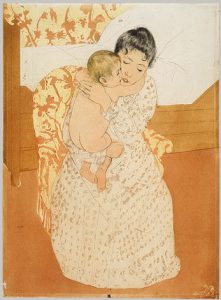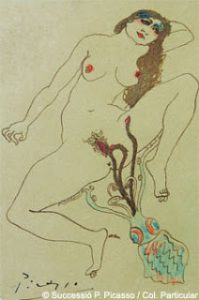The part of this week’s lecture that particularly interested me was ukiyo-e’s influence on art nouveau posters and even on famous Western artists such as Vincent van Gogh. I really like how ukiyo-e was a product of Japan trying to avoid Western influences by literally closing their country off, but had such a huge impact on Western artists when shipped abroad. I would have thought that developing a unique artistic identity through seclusion would result in the works being perceived by foreigners as weird but perhaps we can explore a little bit more on the influence of ukiyo-e.
Ukiyo-e developed from traditional Japanese picture scrolls, and were made using woodblock prints. Making a print involved the collaboration of 3 specializations, namely the artist, block cutter and printer. I find it regrettable that only artists such as Katsushika Hokusai are remembered for their prints, even though they wouldn’t be possible without the block cutter and printer. Ukiyo-e prints sought to portray fleeting moments in everyday life, and most commonly depicted women using flat patches of colour.
This print by Mary Cassat contains numerous examples of influence from ukiyo-e prints. Firstly the background (both the floor and bed) is made out of flat brown swatches with neither depth nor perspective, and the same can be said about the chair which blends into the wallpaper from afar. The colours used are also as unsaturated as those used in ukiyo-e prints, but what really highlights the Japanese influence is how the faces are portrayed. Both the woman and baby’s eyes are reduced to a thin, curved line which is a unique Asian feature, and the black-white gradient on the woman’s hair also resembles how women’s hair was depicted in ukiyo-e.
The focus on portraying women in art nouveau posters might also have stemmed from ukiyo-e prints, as from my research there were far less depictions of men, or perhaps ukiyo-e artists were better at drawing women. Even when depicting a woman engaging in sexual acts with an octopus, the image (top) still retains a certain amount of integrity and is seen as a piece of art, rather than Picasso’s sketch of the same scene (bottom) which resembles rude graffiti. One might argue that Picasso’s sketch was unfinished but I feel the difference lies in the ukiyo-e’s smooth yet realistic lines and pale tones, which is usually how dreams are perceived. Thus, when viewing the original (which is called The Dream of the Fisherman’s wife) a person is more likely to treat it as a fictional image and hence making the scene a little less distasteful.


